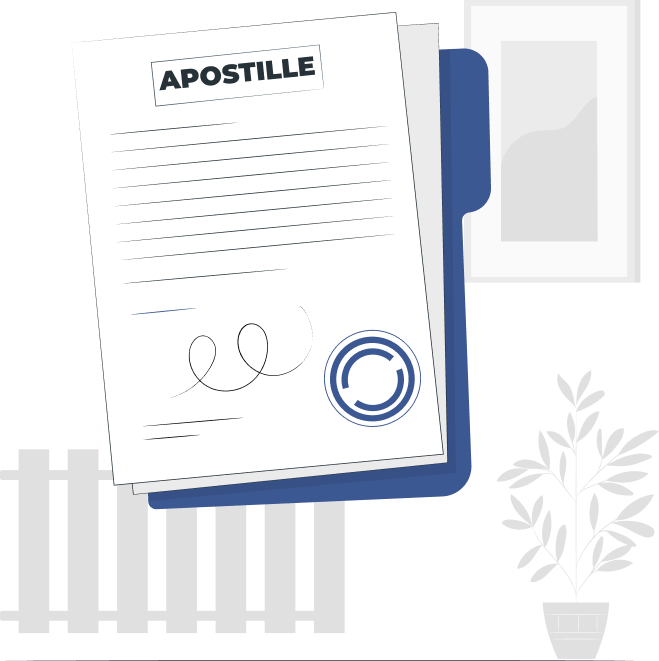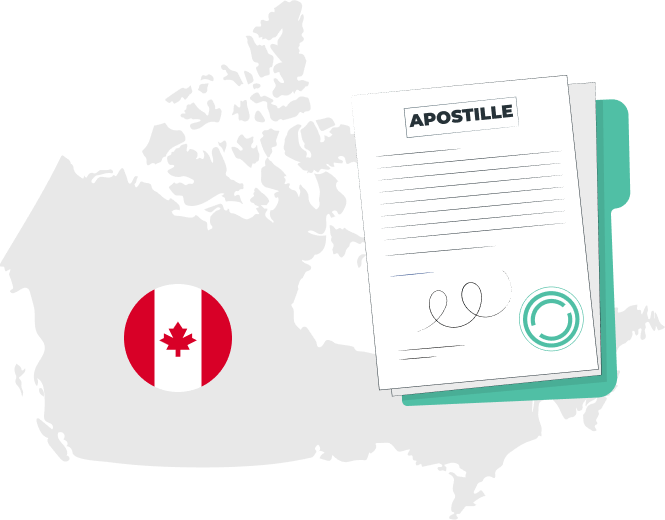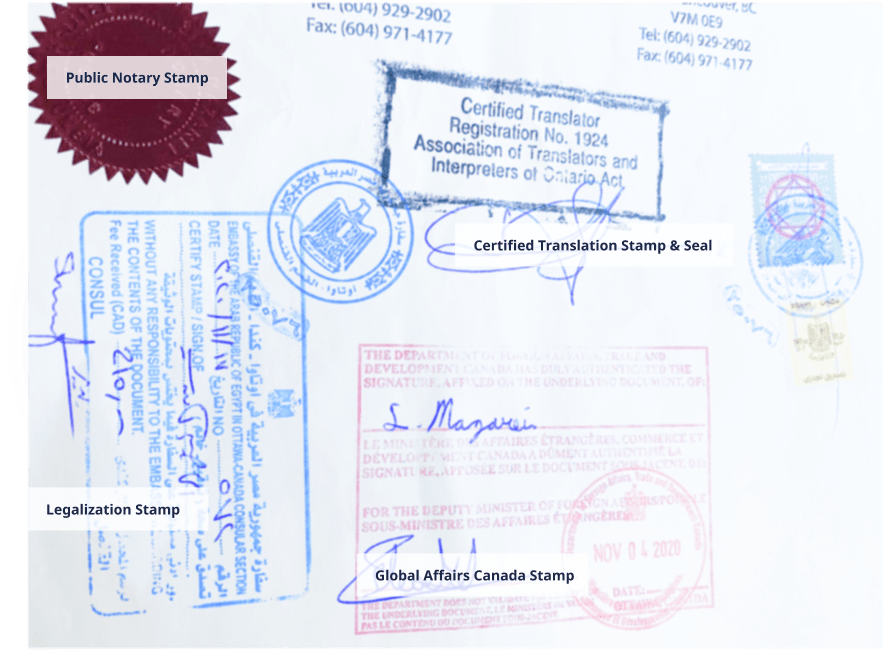
In this guide, we’ll learn everything you need to know about getting an apostille in Canada: document preparation, steps in the process, and when you need an apostille.
We’ll also explain why apostille, authentication, legalization, and attestation are not just fancy words to describe the same process.
The examples included in this guide will help you decide which of these you need.
Go directly to Chapter 3 if you want to quickly know the 2 easy steps to apostille your Canadian documents.

Is there an apostille equivalent?
2 easy steps on how you can get an apostille in Canada
How can I speed up the Canada apostille process?
An apostille is a certificate that is attached to your document. The country that issued the document places this certificate on your document, authenticating its origin. In most cases, you need an apostille before you can use your document abroad.
Public documents include birth certificates, judgments, patents, and notarial attestations of signatures. Chances are that at some point in your life you’ll need to use these documents abroad, be it for study, business or an international move.
However, before apostilles became a thing, countries used another process. This process is called legalization, and some still use it today.
But legalization is far more cumbersome than a simple apostille.
It involves a chain of individual authentications of a single document. Basically, you first have to prepare your document by translating and notarizing it. Officials in the country that issued the document then authenticate it. Once this is done, the foreign embassy or consulate where you will use your document legalizes it.

In the 60s, to make this process more efficient, many countries all over the world joined a treaty called the Hague Convention of 5 October 1961 Abolishing the Requirement of Legalisation for Foreign Public Documents, also known as The Hague Apostille Convention.
This Convention streamlines the slow legalization process to a single formality. The country that issued the public document attaches a certificate to the document. This certificate is called an Apostille stamp, or “allonge”.
Canada joined the Apostille Convention in 2023 and started issuing Apostille certificates in January 2024. Before that date, Canada followed the longer authentication and legalization process.
In simple terms then, an apostille stamp is an easier way to get your documents authenticated for use abroad.
While simple on paper, preparing your documents and finding the right Canadian entity for the apostille can still be time-intensive. There is a faster and more efficient way to do this by outsourcing the process.
We offer fast, easy document authentication, legalization and apostille at a great price. Learn More
As we’ve noted above, authentication and legalization is a process equivalent (but not identical) to an apostille for countries that have not joined the Apostille Convention. Some countries that still use authentication (or attestation) and legalization include Algeria, Bangladesh, Ghana, Lebanon, Qatar and Thailand. You can view a full list of countries which are not signatories to the Apostille Convention here.
Global Affairs Canada issues apostilles for all documents, even those intended for use in a country that has not signed the Apostille Convention.
If you need to use a document in a non-apostille country, you may need to get it authenticated by a competent authority in Canada and then legalized by a representative of the country where you intend to use the document.
Authentication is a stamp that confirms that the signature or seal in your documents is genuine, valid, and recognized.
Authentication services are provided by most provinces and territories in Canada. Authentication offices in Alberta, British Columbia, Manitoba, Ontario, Prince Edward Island, Quebec, Saskatchewan, and Yukon authenticate documents issued or notarized in their jurisdiction. In other words, they verify the signatures on the document and issue a certificate of authentication.
Some countries accept authentications done by the Canadian embassy, high commission or consulate in that same country, while others accept a direct legalization done by their embassy, high commission or consulate, without a prior authentication.
You should always check with the entity requesting your documents to find out their specific requirements.
Authentication is generally followed by another step: legalization.
A legalization is a stamp that confirms the document’s validity, clearing it for use abroad. The embassy or consulate of the foreign country where you intend to use your document legalizes the document.
Now that we’ve explained these two terms, we’ll walk you through a step-by-step guide on the apostille process in Canada.

Getting your documents apostilled in Canada is a two-step process.
STEP 1: Prepare your documents for an apostille: get your documents notarized and translated (if applicable).
STEP 2: Submit your documents to Global Affairs Canada or a provincial competent authority.

Depending on the nature of your document, you may need to get it translated and notarized before submitting it to Global Affairs Canada or other competent authorities.
If all or part of your document is written in a language other than English or French (in the case of Canada), you must first get it translated.
Global Affairs Canada only accepts certified and notarized translations for authentication purposes. So you cannot translate the document yourself or get a friend to do it.
A certified translation is a translation completed by a translator who has the title of “certified translator”. Provincial regulatory bodies grant this title in Canada.
Certified translations include the translator’s declaration, signature, and seal. The translator accepts responsibility for the translation’s accuracy.
The Canadian Translators, Terminologists, and Interpreters Council provides a directory of provincial associations of translators. You can use this directory to find a certified translator close to you.
Once a translator translates your foreign language, the translation has to be notarized. A notarized translation goes one step further. A notary public signs and places an official seal on the document. Unlike the translator, the notary does not check the accuracy of the translation. The notary simply confirms the identity of the translator.
Some documents, including those issued by the Government of Canada, must be notarized before an apostille can be issued.
In a notarization:

An apostille certificate confirms that the signature or seal on your documents is genuine, valid, and recognized.
For this step, you must send your documents to Global Affairs Canada or a provincial competent authority. Where you send the documents depends on where they were issued or notarized:
– Global Affairs Canada apostilles documents issued by the Government of Canada and documents issued or notarized in Manitoba, New Brunswick, Newfoundland and Labrador, Northwest Territories, Nova Scotia, Nunavut, Prince Edward Island, and Yukon. If your document was notarized in one of these provinces or territories but issued elsewhere, you will still send it to Global Affairs Canada.
– Documents issued or notarized in Alberta, British Columbia, Ontario, Quebec, and Saskatchewan must be submitted to these provinces’ competent authority. If your document was notarized in Alberta, Ontario, or Saskatchewan, send it to that province’s competent authority, regardless of where it was issued. In British Columbia and Quebec, the competent authority authenticates a notarized document only if the original was issued there.
Before submitting your documents, ensure that it is an original document with a recognized signature and, if applicable, a seal.
Global Affairs Canada and all other competent authorities study the document to confirm that the signature or seal on your document is genuine. If all’s well, they issue an apostille certificate.
The apostille validates your Canadian document for use abroad.